Visit Germany


|
Millions of reviews.
Nothing but the best.  Berlin is an edgy city, from its fashion to its architecture to its charged political history. The Berlin Wall is a sobering reminder of the hyper-charged postwar atmosphere, and yet the graffiti art that now covers its remnants has become symbolic of social progress. Check out the Weltzeituhr (world time) Clock, topped by a model of the solar system, then turn back...Berlin is an edgy city, from its fashion to its architecture to its charged political history. The Berlin Wall is a sobering reminder of the hyper-charged postwar atmosphere, and yet the graffiti art that now covers its remnants has become symbolic of social progress. Check out the Weltzeituhr (world time) Clock, topped by a model of the solar system, then turn back time by dining at the historic Zur Letzten Instanz, a 16th century restaurant that was frequented by Napoleon and Beethoven. The Brandenburger Tor is a monumental gate built in the eighteenth century as a symbol of peace. During the Cold War, when the gate was located right near the border between East and West Berlin, it became a symbol of a divided city.
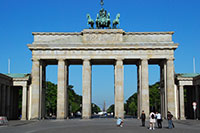
Brandenburg Gate
Since the fall of the Berlin Wall, the Brandenburg Gate has become the symbol of a reunified Berlin. The desolate area that Pariser Platz was during the Cold War, is now completely redeveloped and has regained much of its nineteenth-century grandeur.
Brandenburg GateThe Brandenburg Gate is situated at the end of Unter den Linden, a grand boulevard in Berlin. It was originally part of a wall surrounding Berlin and was the main entrance to the city. It is the only gate that remains of this former city wall.
The monumental gate was designed by Carl Gotthard and commissioned by emperor Wilhelm II. The design of the gate, 65.5 meter wide and 28 meter tall was based on the Propylaea, the gateway to the Acropolis in Athens. It was constructed between 1778 and 1791 and replaced an older city gate. The decorations, including bas-relief scenes depicting Greek mythology took another four years to complete. Quadriga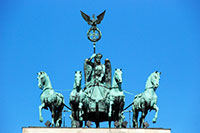
The Quadriga
The quadriga of victory crowning the gate was built in 1793 by Johann Gottfried Schadow. The bronze quadriga is driven by the goddess of peace; originally the gate was a symbol of peace.
In 1806, during Berlin's occupation by France, Napoleon ordered the quadriga to be taken to Paris. After the Battle of Waterloo, the quadriga was triumphantly taken back to Berlin, and it was turned into a symbol of victory. At the same time the square near the gate was renamed Pariser Platz and the statue on the quadriga was now called Victoria, after the Roman goddess of Victory. After WWIIThe gate, which by that time had become a symbol of Prussian militarism, was badly damaged during World War II. After the war and the division of Berlin, the Brandenburg Gate was right at the border between East and West Berlin, just inside the Russian sector.
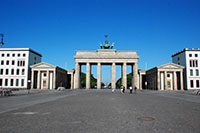
Pariser Platz
Berlin WallAfter the construction of the Berlin Wall in 1961 which was built right near the Brandenburg Gate, the Pariser Platz, on the East-Berlin side, became completely desolate. The gate symbolized Germany's division. With the fall of the wall in 1989, people flocked to the reopened Brandenburg Gate to celebrate.
The monument was renovated again in 2001; it opened as good as new on October 3, 2002. Once the busiest crossing in Europe, the Potsdamer Platz was completely destroyed after the war. In 1998 the new Potsdamer Platz, full of modern buildings, officially opened.
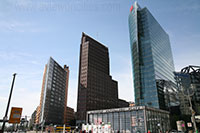
Potsdamer Platz
In the 1920s and 30s, the Potsdamer platz was the busiest and one of the liveliest squares in Europe. It was a major public transport hub and a popular entertainment district; the area contained numerous bars, cafés and cinemas.
This all came to an abrupt end in 1943 when the Potsdamer platz was left to ruins by allied bombing. After the second world war, the square located between the American, British and Russian sectors, became a no-man's land. 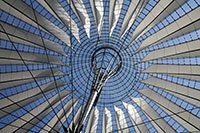
Tent-like roof of the Sony Center
Redevelopment
After the fall of the Berlin Wall it was decided to rebuild the whole area, 480.000 square meter large. Construction started in 1994 and for many years Potsdamer Platz became the largest construction site in Europe. The square, together with several adjacent blocks were redeveloped
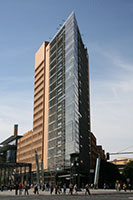
Debis Building B1
The project included the construction of several landmark towers, a shopping arcade, an entertainment center and residential buildings. The first building completed was the Debis tower, designed by Renzo Piano. Other eyecatchers are the Sony Center, a complex designed by Helmut Jahn which includes an Imax theater and an office tower. Its neighbor, the brown-brick Kohlhof building featured an observation deck at a height of 93m. The square today
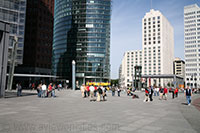 The large new underground station, shopping arcade and entertainment center have brought new life to thePotsdamer Platz.
It still is more of a tourist attraction than a 'natural' square, but with the construction of more residential buildings in the neighborhood, the area has started to grow back to its former status: one of the liveliest squares in the country. One of the largest zoological gardens in the world, Berlin's Zoologischer Garten has been thrilling visitors since it opened more than 150 years ago.
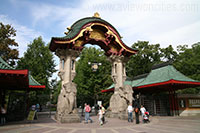
Elephant Entrance
First opened to the public in 1844, the Berlin Zoo was built upon a gift bestowed to the city by King Friedrich Wilhelm IV. The king provided animals from his menagerie to fill the cages and open habitats at the zoo, which was designed by Peter Lenne.
The idea for the zoo was the brainchild of Alexander von Humboldt and German-born African explorer and zoologist Heinrich Lichtenstein. It occupies the southwest portion of the Tiergarten, a large public park in the center of Berlin.
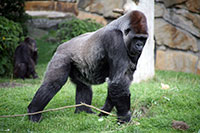 The zoo's population increased rapidly and literally thousands of animals had taken up residence there by the early to mid 1900s and the zoo was a popular attraction for those visiting the city, but after the destruction caused by the
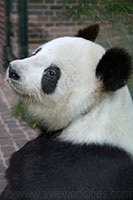 The Zoo Today
These days, as you enter the Zoologischer Garten through its Elephant or Lion Gates, you'll be treated to more than 15,000 animals representing about 1,400 species. Cages are rare. Most animals roam free in re-creations of their natural habitats.
Pandas and more
The pandas are the most popular residents of the Berlin Zoo,
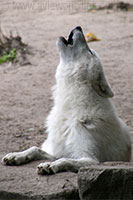 The Birdhouse is one of the most modern in Europe, boasting more than 500 species of birds, many of them quite rare. The polar bears were also very popular when Knut - a polar bear cub rejected by its mother - was fed by one of the zookeepers. Among the other well known species in the zoo are wolves, gorillas, elephants, seals, zebras, rhinoceros, lions, orangutans, giraffidae and okapis. 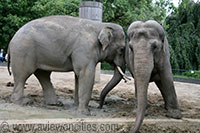 There's also an excellent aquarium adjacent to the zoo (you can buy a combo ticket) where you'll find not only fish but also insects, amphibians, and reptiles.
Kids love the Children's Zoo, where they can pet the animals, as well as the onsite playground, providing lots of room to run around after a long day of sightseeing. Entrances
The zoo has two entrances, one is situated at the Hardenbergerplatz and is known as the Lion Gate since it is flanked by two small buildings with statues of resting lions. The other entrance, at the Budapester Strasse, is flanked by statues of elephants, appropriately known as the Elephant Gate.
The Berliner Fernsehturm is a television tower which rises to a height of more than 360 meters from its futuristic looking base at the southwest side of Alexanderplatz. The tower is the tallest structure in Berlin and can be seen from almost anywhere in the city.
An iconic towerThe idea for the tower was launched in 1958, when the government of East Germany wanted to erect an iconic office tower at Alexanderplatz. In response, German architects Jörg Streitparth and Hermann Henselmann - a socialist architect known for his towers at the Karl Marx-Allee - proposed the construction of a television tower which was to be known as the 'Tower of Signals'.
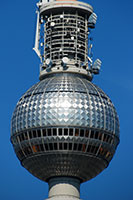
The sphere
ConstructionThe idea was unrealized until the end of the 1960s when it was relaunched. A team of East German architects designed the 368 meter (over 1200ft) tall concrete tower which was built with the help of Swedish engineers.
The structure consist of a large pavilion covered with white painted roofs enclosing the actual tower, a cylindrical concrete shaft topped by a steel-clad sphere and a large antenna. When it opened in 1969 the tower was the pride of the DDR and communist propaganda films were shown here to promote the quality of life in East Berlin. Even today the tower is one of Berlin's most important landmarks, and in 1993 it was even officially designated as such. 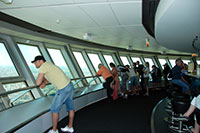
Viewing Platform
Viewing platformElevators at the base of the tower bring visitors to the large sphere, where a viewing platform allows for a 360 degree view of Berlin from a height of about 203 meters. Depending on the weather visibility can reach up to 40 km (25 miles). Just above the platform, at a height of 207 meter, is the Telecafé, a revolving restaurant.
One of the masterpieces of the area known as Museum Island, the Altes Museum (Old Museum) was the first dedicated museum building in Berlin.
The building and statues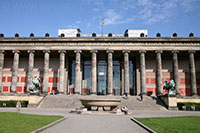
Altes Museum
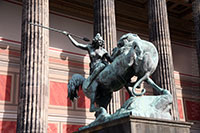
Statue at the entrance
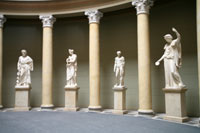
Rotunda
In the 17th century, princess Louise, daughter of Friedrich Wilhelm - also known as The Great Elector - built a beautiful pleasure garden on the tip of an island on the River Spree. Many years later, when one of his descendants ruled over Prussia, the need arose for a museum to house many of Germany's treasures, which had recently been recovered from France.
Thus, in the 1820s, Berlin's great architect Karl Friedrich Schinkel devised a plan for a new museum bordering the garden. Built between 1825 and 1830, the Altes Museum was the first in the city, fashioned in the Greek style. It was situated across the garden from the King's Palace, which was demolished World War II. Eighteen Ionic columns grace the front of this grand museum. The rectangular shaped building encloses two generous courtyards and a two-story centrally-located rotunda, based on the design on the Pantheon in Rome. The interior of the rotunda contains sculptures of gods of antiquity in the recesses of its walls. Two statues flank the wide outdoor steps. Entitled Amazon and Lion Fighter, they were designed by August Kiss and Albert Wolff. 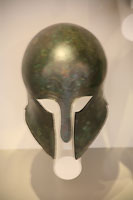
Greek Helmet
The Museum CollectionAfter the war, the Altes Museum was the first of the group museums on Museum Island to be renovated and it reopened in 1966. Today, it houses the Antikensammlung (Museum of Antiquities) on its main floor. The permanent collection here includes a vast variety of ancient Greek and Roman decorative art including vases and statues.
The Alte Nationalgalerie (Old National Gallery) is one of a group of museums at Berlin’s centrally located Museum Island. The museum boasts a fine collection of 19th century artwork, mainly paintings and sculptures from the German romantic period.
Building the Gallery
Plans for the
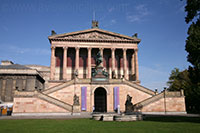
Alte National
galerie Work on the gallery began in 1866 but, unfortunately, Stüler died later that year. The management of the site reverted to Johann Heinrich Strack, who oversaw the project until its completion 10 years later, in 1876.
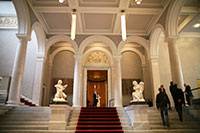
Main Hall
The Alte Nationalgalerie was largely destroyed during World War II. Many of the paintings and other works of art were
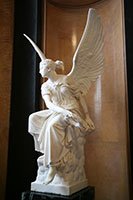 Despite the massive amount of destruction, the museum was partially re-opened by 1949. However, Germany was soon to be divided and with the political division of Germany came the division of the collection at the Old National Gallery. Eventually, after the wall fell, the collection was reunited. Complete restoration of the museum
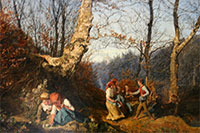 About the Collection
Alte Nationalgalerie is most well-known for its fine collection of 19th century paintings. It's also home to the world's largest collection of works by the city's native son, Adolph von Menzel (1815-1905). The museum, the first on the island to be completely restored, also owns an impressive collection of 19th century sculpture.
The Soviet War Memorial in Treptower Park is the largest of several memorials that were built in Berlin to honor the Red Army soldiers who were killed in the Second World War.
The Great Patriotic War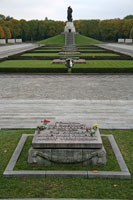
Soviet War Memorial
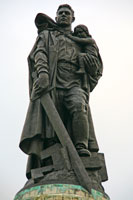
The Big Soldier
During the Second World War - known in Russia as 'The Great Patriotic War' - the Soviet Union suffered the largest losses of all nations involved, with more than twenty-five million of its people killed. During the battle of Berlin alone, which was fought between April 16 and May 2, 1945, 22,000 Soviet soldiers lost their lives.
To honor these soldiers and to celebrate the Red Army's victory over Germany the Soviet military ordered the construction of several memorials. The largest of these was built between 1946 and 1949 in Treptower Park, in southeast Berlin, where more than 7,000 Red Army soldiers were buried. ConstructionA competition organized to design the memorial received thirty-three submissions. An entry by a collaborative group consisting of an architect, an engineer, a sculptor and a painter was selected. A site of about ten hectares (25 acres) in the former borough of Treptow was chosen as the location for the memorial.
The bombastic memorial was built under the guidance of the Soviet Army with the help of almost 1,200 German workers. The memorial was officially dedicated on May 8, 1949 (the fourth anniversary of the surrender of the German army), by the Soviet commander in Berlin, Major General Alexander Kotikov. The Memorial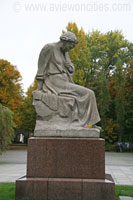
Mother Homeland
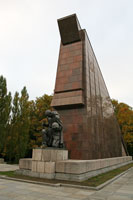
Marble wall
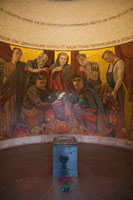
The crypt
The memorial was built in typical Stalinist style, with lots of symbolism and patriotic glorification. What the memorial lacks in artistic quality is compensated by sheer monumentalism.
Mother HomelandStone arches on two avenues - Pushkinallee and Am Treptower Park - mark the north and south entrance of the memorial site. They lead to an allegorical granite statue of Mother Homeland grieving for her dead children. Mother Homeland personifies the Soviet Union; before 1917 she was known as Mother Russia.
EsplanadeFrom here an esplanade lined with weeping birches creates a vista towards the centerpiece of the memorial: a colossal bronze statue of a Soviet soldier, the so-called 'Big Soldier'. The view is framed by two massive triangular-shaped walls guarded by statues of kneeling soldiers. The walls, engraved with hammer and sickle, symbolize lowered flags. They are made of red marble that is thought to come from the ruins of the New Reich Chancellery. From the end of the esplanade visitors have a view over the sunken cemetery.
CemeteryThe cemetery is decorated with two rows of limestone sarcophagi, sixteen in total. They represent the former republics of the USSR and are decorated with reliefs that depict scenes from the war. Quotes from Stalin are inscribed on the sarcophagi in German and Russian.
Big SoldierThe memorial culminates in a massive heroic monument known as the 'Big Soldier'. It shows a Soviet soldier holding a rescued child, a symbol of liberation. In his right hand he holds a sword that rests on a broken swastika. The bronze monument has a height of more than eleven meters (36 ft) and weighs about seventy tons. It was created by Yevgeny Vuchetich and cast in 1949 in Leningrad before it was transported in six pieces to Berlin.
|
|||
 |
 Hamburg..Second only to Berlin in size and population, the city of Hamburg is home to one of the biggest harbors in Europe. A stroll along its many waterways and canals illustrates why it has been called the "Venice of the North." Don't miss a trip to the local fish market (Fischmarkt), the Merchants District (marked by its imposing red-brick architecture), a fine dining...Second only to Berlin in size and population, the city of Hamburg is home to one of the biggest harbors in Europe. A stroll along its many waterways and canals illustrates why it has been called the "Venice of the North." Don't miss a trip to the local fish market (Fischmarkt), the Merchants District (marked by its imposing red-brick architecture), a fine dining experience along the river or a night out in the university quarter. And did we mention the Reeperbahn (red light district)? It's quite famous for its… red lights. Port of HamburgAbout 13,000 ships from all over the world call at Europe's second largest port. From the cruise ship terminal to the historic Speicherstadt and the jetties to the modern container port - it smells like freedom and distant countries here.When taking a barge tour or visiting one of the legendary museum ships, visitors can experience first hand why Hamburg is also called the "Gateway to the World". You can also find a great variety of things from all over the world every Sunday at the legendary Hamburg Fish Market. From 5.00am - 9.30am (in the winter months - from 16 November to 14 March - from 7.00am) - pretty much everything that is not bolted down is traded here, as it has been since 1703, be that kilos of fish at a bargain price, dusty porcelain jugs or a chirpy family of ducks. And since summer 2007, the world of emigrants at "Ballinstadt" has brought another very special part of Hamburg's harbour history to life. At the very site from where about 5 million European emigrants began their journey to the "New World" between 1850 and 1939 people can now investigate their own family’s history today. Do you have wanderlust? In our maritime world, you can find detailed tips and information about port tours, venerable tall ships, arrivals of luxury cruisers as well as about spectacular construction projects like the HafenCity and the Elbphilharmonie. A legend and a must-see for all visitors to Hamburg: Since 1703, pretty much everything that is not bolted down has been traded here at Hamburg's most traditional market. From dusty porcelain jugs to a chirpy family of ducks, you can find just about anything in the shadow of the 100-year old fish auction hall.Half the jungle is sold here directly in the pot and from the lorry, bananas fly through the air, plastic bags full of sausage go to the owner for a ridiculously low price, "Aale-Dieter" bellows his from the pit of his stomach, crowds of people in front of the traders' cars - you have to experience it (and it's worth getting out of bed early once to do so)! Revellers from the Reeperbahn stand on the water's edge with fish sandwiches and coffee in hand waiting for their spirits to be revived, others "guard the loot" they have purchased - for some the day is just beginning, while for others yesterday has not ended! Brunch in the historic fish auction hall with jazz, skiffle or country and western music is a special highlight.  SpeicherstadtThe century-old Speicherstadt, the world's largest contiguous warehouse complex, is located in the Freihafen (free-port) between Deichtorhallen and Baumwall. An idyll that one would hardly imagine finding in a world port waits there for visitors to Hamburg. Wilhelmine brick Gothic from the late nineteenth century, bizarre gables and turrets which reflect the barges in the canals.The Speicherstadt, a Hamburg landmark, is one of the main attractions in the great harbour tour. The world's largest integrated complex of warehouses was built in 1883, five years before Hamburg received its free port. Since 1991, the unique district has been given historic monument protection. The warehouses are built on oak piles and the district is crossed by what are known as fleets - canals that are flooded depending on the tides and can then also be travelled by ship. You can travel the narrow canals in small barges to savour the architectural details if the tide is right. A canal tour with a historic barge like this is an unforgettable experience. Most tours depart from the landing stages in St. Pauli. Groups can even charter a whole barge. At nightfall, the Speicherstadt is enveloped in an aura of mystery. At that time of day, the red brick buildings and steel bridges are artfully illuminated by 800 spotlights. Enjoy the fairytale atmosphere of illuminated façades, reflections in the water and the spicy aromas of goods from around the world 365 days a year... The "Lichtkunst Speicherstadt" project was realised by the Verein Licht-Kunst-Speicherstadt e.V. Its 50 members provide the lighting, power supply and carry out maintenance and repair. Tip: The Speicherstadt in Hamburg can also be explored by water, for example. The different attractions of the Speicherstadt are also easily accessible with the city tour bus . Right next to the Speicherstadt, the futuristic HafenCity project is currently being built. The planning of the housing scheme of the future naturally fascinates many visitors, and tours are offered accordingly that also pass by the Elbphilharmonie construction site, the Spiegel Group publishing building as well as numerous top restaurants. Hamburg Town HallHamburg Town Hall was built from 1886 to 1897 and with its impressive architecture dominates the centre of the city. The magnificent sandstone building houses the city's senate and parliament.After Hamburg Town Hall burned to the ground in 1842, the city council temporarily moved into provisional premises - for 55 years! The new Town Hall was inaugurated in 1897, has 647 rooms and stands on over 4,000 oak piles. In stark contrast to the restrained Hanseatic style, the Town Hall is conspicuous due to its elaborately decorated façade, flanked by a total of 20 statues of emperors. The following is written in Latin above the main door: "The descendants shall seek worthily to maintain the freedom achieved by their forebears." The ornate wrought iron gate of the main entrance door leads into the entrance hall which is supported by 16 sandstone pillars painted with 68 portraits of worthy Hamburg citizens. The staircase was made from Sardinian marble and shows the course of human life. The debating chamber is designed rather simply and Parliament meets here every second Tuesday at 3.00pm Portraits of former speakers of parliament hand in the adjacent Bürgersaal where citizens are received. The Kaisersaal (imperial hall) - named because of the visit by Kaiser Wilhelm II at the opening of the North Sea-Baltic Canal - has a striking ceiling painting that symbolises merchant shipping under the German flag. The walls are decorated with wall coverings made of pressed leather. The Tower Hall accommodates celebrations on special occasions and receptions. Guests make entries into the Golden Book in the Mayor's Hall with its enormous fireplace. A painting hangs here that depicts the inauguration of the Town Hall in 1897. The Phoenix Hall is named after the phoenix above the fireplace, which is meant to symbolise Hamburg's renaissance after the great fire of 1842. In the Senate chamber, the only light passes through the large glass roof: This symbolises the ancient Germanic custom that the council meets in the open air. The Grand Ballroom is 46 metres long, 18 metres wide and 15 metres high. Five huge paintings depict the history of Hamburg from 800 to 1900 and 62 city coats of arms of the old Hanseatic League decorate the walls. The three chandeliers with 278 lights each weigh 1,500 kilograms!
|
|||
 Dresden.... On the banks of the lovely Elbe River, the German city of Dresden is lush and green, filled with forests and gardens and parks. The city is rich with cultural and artistic history; the great operatic composer Wilhelm Wagner debuted a number of works here in the 1800s and, today, an independent light opera company keeps the classical art form modern and fresh. Culture...On the banks of the lovely Elbe River, the German city of Dresden is lush and green, filled with forests and gardens and parks. The city is rich with cultural and artistic history; the great operatic composer Wilhelm Wagner debuted a number of works here in the 1800s and, today, an independent light opera company keeps the classical art form modern and fresh. Culture vultures will love the Gemäldegalerie Alte Meister and Grünes Gewölbe museums, and architecture buffs will salivate over the mélange of styles reflected in the cityscape.
|
|||
 Frankfurt....There’s plenty to see and do in this 2,000-year-old German city. The gothic Saint Bartholomeus Cathedral is a perseverant structure, having been destroyed and rebuilt twice since its 14th century construction. Catch a screening at the German Film Museum, stroll the exhibit halls of one of Frankfurt’s many galleries, or climb to the top of the Main Tower for sweeping...There’s plenty to see and do in this 2,000-year-old German city. The gothic Saint Bartholomeus Cathedral is a perseverant structure, having been destroyed and rebuilt twice since its 14th century construction. Catch a screening at the German Film Museum, stroll the exhibit halls of one of Frankfurt’s many galleries, or climb to the top of the Main Tower for sweeping 360-degree views of the city. |
|||
 Cologne....There are 2,000 years of history in Cologne, and visitors here will find everything from Roman towers to Gothic churches to fine examples of modern architecture. Cologne has a variety of museums, too—check out the Museum of Applied Art, the Museum Ludwig and, if you have a sweet tooth, the Chocolate Museum. Be forewarned, though—the gift shop at the latter will...There are 2,000 years of history in Cologne, and visitors here will find everything from Roman towers to Gothic churches to fine examples of modern architecture. Cologne has a variety of museums, too—check out the Museum of Applied Art, the Museum Ludwig and, if you have a sweet tooth, the Chocolate Museum. Be forewarned, though—the gift shop at the latter will utterly ruin your diet. |
|||
 Oberstdorf...One of Germany’s biggest and best-known resorts, Bavarian Alpine village Oberstdorf is popular with families year round. It’s home to Heini-Klopfer-Skiflugschanze, the world's second largest ski-jumping hill (and site of the famous "agony of defeat" ski-jump wipeout clip from ABC's Wide World of Sports). Nearby are the ski areas of Nebelhorn, Kanzelwand/Fellhorn and...One of Germany’s biggest and best-known resorts, Bavarian Alpine village Oberstdorf is popular with families year round. It’s home to Heini-Klopfer-Skiflugschanze, the world's second largest ski-jumping hill (and site of the famous "agony of defeat" ski-jump wipeout clip from ABC's Wide World of Sports). Nearby are the ski areas of Nebelhorn, Kanzelwand/Fellhorn and Kleinwalsertal. |
|||
 Rothenburg’s....Walk atop Rothenburg’s city walls or climb to the top of the town hall for great views. The Night Watchman tour is an unforgettable way to learn the city’s history. And our travelers also recommend the Medieval Crime Museum (Mittelalterliches Kriminalmuseum)—it’s gruesome but fascinating. |
|||
 Berchtesgaden....Winter sports enthusiasts will love Berchtesgaden, a village in the German Alps with several ski slopes and a top-notch bobsled track. Visit the Berchtesgaden Salt Mines (TripAdvisor travelers rave about their slides!). Nearby Lake Königsee makes a great day trip.
|
|||
 Dusseldorf ....The capital of North Rhine-Westphalia, Dusseldorf is a regional economic powerhouse straddling the banks of the Rhine River. Altstadt is not just Dusseldorf's lovely old town, but also where the city's nightlife is based and where Altbier, its native dark beer, is plentiful. Dusselforfians take their beer seriously. Königsallee (Ko to the locals), Dusseldorf's famous..The capital of North Rhine-Westphalia, Dusseldorf is a regional economic powerhouse straddling the banks of the Rhine River. Altstadt is not just Dusseldorf's lovely old town, but also where the city's nightlife is based and where Altbier, its native dark beer, is plentiful. Dusselforfians take their beer seriously. Königsallee (Ko to the locals), Dusseldorf's famous shopping street, has many high-end stores. And the Museum Kunst Palast has one of the Rhineland's best art collections. |
|||
Top 10 Things to See in Stuttgart, Germany |
Top 10 things to do in the Bavarian AlpsWhat not to miss on a trip to the Bavarian Alps.
1. Visit Neuschwanstein CastleIt’s kitsch, it’s over the top, it’s absolutely stunning and it’s a definite must-see! Walking up the steep hill to “Schloss Neuschwanstein” is breathtaking, but the site of this fairytale castle looking down on the village of Füssen will leave you lost for words for more than one reason. King Ludwig II asked his architects to build an idealised version of a medieval knight’s castle and this is “castle romanticism” at its best. Originally intended as his own private retreat, the castle was opened to the public only a few weeks after Ludwig’s death in 1886. Each year some 1 million people are drawn to the palace by its unique and inimitable allure. There are tourist traps worth visiting and Neuschwanstein Castle is definitely one of them. More about castles in Bavaria...
|













